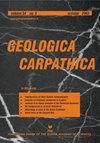Stress analysis from the southern part of Moravian Karst (Czech Republic)
IF 1.5
4区 地球科学
Q4 GEOSCIENCES, MULTIDISCIPLINARY
引用次数: 0
Abstract
: Data from three quarries in the southern Moravian Karst (SE Czech Republic), namely fault-slip data and calcite twinning data, enabled a side-to-side comparison of two paleostress analysis techniques. TwinCalc (www.eltekto.cz) was used to analyse 8 samples of calcite veins, yielding 20 stress states and MARK was used to analyse the fault-slip data yielding 10 stress states. 26 out of these 30 stress tensors were sorted into four stress phases (P1–P4) using a stress tensor similarity cluster analysis based on angles between stress tensor 9D vectors. The oldest phase is P4 – N–S trending compression. P1 is younger, and responsible for the reactivation of NW–SE striking dextral strike-slip faults. Both are post-Cretaceous pre-Langhian phases. The second-to-last phase is P3 associated with WNW–ESE striking mostly normal faults. This stress state had been active during the Miocene before the Tortonian P2 phase. The last phase is the Tortonian P2 phase, which is characterised by NNE–SSW striking dextral strike-slip faulting.捷克摩拉维亚喀斯特南部的应力分析
捷克共和国东南部摩拉维亚喀斯特南部三个采石场的断层滑动数据和方解石孪生数据使两种古应力分析技术得以进行横向比较。利用TwinCalc (www.eltekto.cz)对8个方解石脉样品进行分析,得到20种应力状态;利用MARK对断滑数据进行分析,得到10种应力状态。采用基于应力张量9D向量夹角的应力张量相似聚类分析方法,将这30个应力张量中的26个划分为P1-P4四个应力阶段。最老相为P4 - N-S向压缩。P1更年轻,是北西-东向右走滑断裂重新活化的原因。均为白垩纪前朗玄期。倒数第二阶段是P3,与WNW-ESE有关,主要是正断层。在托尔顿P2期之前的中新世,这种应力状态一直活跃。最后一期为托尔顿期P2期,以NNE-SSW走向右走滑断裂为特征。
本文章由计算机程序翻译,如有差异,请以英文原文为准。
求助全文
约1分钟内获得全文
求助全文
来源期刊

Geologica Carpathica
地学-地球科学综合
CiteScore
2.40
自引率
23.10%
发文量
26
审稿时长
>12 weeks
期刊介绍:
GEOLOGICA CARPATHICA covers a wide spectrum of geological disciplines including geodynamics, tectonics and structural geology, volcanology, stratigraphy, geochronology and isotopic geology, karstology, geochemistry, mineralogy, petrology, lithology and sedimentology, paleogeography, paleoecology, paleobiology and paleontology, paleomagnetism, magnetostratigraphy and other branches of applied geophysics, economic and environmental geology, experimental and theoretical geoscientific studies. Geologica Carpathica , with its 60 year old tradition, presents high-quality research papers devoted to all aspects not only of the Alpine-Carpathian-Balkanian geoscience but also with adjacent regions originated from the Mediterranean Tethys and its continental foreland. Geologica Carpathica is an Official Journal of the Carpathian-Balkan Geological Association.
 求助内容:
求助内容: 应助结果提醒方式:
应助结果提醒方式:


